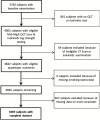Cigarette Smoking Is Associated With Lower Quadriceps Cross-sectional Area and Attenuation in Older Adults
- PMID: 31091312
- PMCID: PMC7249920
- DOI: 10.1093/ntr/ntz081
Cigarette Smoking Is Associated With Lower Quadriceps Cross-sectional Area and Attenuation in Older Adults
Abstract
Introduction: In addition to well-established links with cardiovascular and respiratory diseases, cigarette smoking may affect skeletal muscle; however, associations with quadriceps atrophy, density, and function are unknown. This study explored the associations of current and former smoking with quadriceps muscle area and attenuation as well as muscle force (assessed as knee extension peak torque) and rate of torque development-a measure of muscle power in older adults.
Methods: Data from 4469 older adults, aged 66-95 years at baseline in the Age, Gene/Environment Susceptibility-Reykjavik Study with measurements of thigh computed tomography, isometric knee extension testing, self-reported smoking history, and potential covariates were analyzed.
Results: Sex differences were observed in these data; therefore, our final analyses are stratified by sex. In men, both former smokers and current smokers had lower muscle area (with β= -0.10, 95% confidence interval [CI] = -0.17 to -0.03 and β = -0.19, 95% CI = -0.33 to -0.05, respectively) and lower muscle attenuation (ie, higher fat infiltration, β = -0.08, 95% CI = -0.16 to -0.01 and β = -0.17, 95% CI = -0.34 to -0.01, respectively) when compared with never smokers. Smoking status was not associated with male peak torque or rate of torque development. In women, current smoking was associated with lower muscle attenuation (β = -0.24, 95% CI = -0.34 to -0.13) compared to never smoking. Among female smokers (current and former), muscle attenuation and peak torque were lower with increasing pack-years.
Conclusions: Results suggest that cigarette smoking is related to multiple muscle properties at older age and that these relationships may be different among men and women.
Implications: This article presents novel data, as it examined for the first time the relationship between smoking and computed tomography-derived quadriceps muscle size (cross-sectional area) and attenuation. This study suggests that current cigarette smoking is related to higher muscle fat infiltration, which may have significant health implications for the older population, because of its known association with poor physical function, falls, and hip fractures.
© The Author(s) 2019. Published by Oxford University Press on behalf of the Society for Research on Nicotine and Tobacco. All rights reserved. For permissions, please e-mail: journals.permissions@oup.com.
Similar articles
-
Association of smoking with abdominal adipose deposition and muscle composition in Coronary Artery Risk Development in Young Adults (CARDIA) participants at mid-life: A population-based cohort study.PLoS Med. 2020 Jul 21;17(7):e1003223. doi: 10.1371/journal.pmed.1003223. eCollection 2020 Jul. PLoS Med. 2020. PMID: 32692748 Free PMC article.
-
Associations of Quadriceps Torque Properties with Muscle Size, Attenuation, and Intramuscular Adipose Tissue in Older Adults.J Gerontol A Biol Sci Med Sci. 2018 Jun 14;73(7):931-938. doi: 10.1093/gerona/glx262. J Gerontol A Biol Sci Med Sci. 2018. PMID: 29342246 Free PMC article.
-
Cigarette smoking and hip volumetric bone mineral density and cortical volume loss in older adults: The AGES-Reykjavik study.Bone. 2018 Mar;108:186-192. doi: 10.1016/j.bone.2018.01.014. Epub 2018 Jan 10. Bone. 2018. PMID: 29331300 Free PMC article.
-
Skeletal muscle properties and fatigue resistance in relation to smoking history.Eur J Appl Physiol. 2008 Sep;104(1):103-10. doi: 10.1007/s00421-008-0792-9. Epub 2008 Jun 17. Eur J Appl Physiol. 2008. PMID: 18560879 Free PMC article.
-
Cigarette Smoking and Asthma.J Allergy Clin Immunol Pract. 2022 Nov;10(11):2783-2797. doi: 10.1016/j.jaip.2022.04.034. Epub 2022 May 6. J Allergy Clin Immunol Pract. 2022. PMID: 35533997 Review.
Cited by
-
The effects of community education on tobacco use among older adults in China.Tob Induc Dis. 2025 May 28;23. doi: 10.18332/tid/204512. eCollection 2025. Tob Induc Dis. 2025. PMID: 40438228 Free PMC article.
-
The acute effects of cigarette smoke exposure on muscle fiber type dynamics in rats.PLoS One. 2020 May 20;15(5):e0233523. doi: 10.1371/journal.pone.0233523. eCollection 2020. PLoS One. 2020. PMID: 32433675 Free PMC article.
-
Association of smoking with abdominal adipose deposition and muscle composition in Coronary Artery Risk Development in Young Adults (CARDIA) participants at mid-life: A population-based cohort study.PLoS Med. 2020 Jul 21;17(7):e1003223. doi: 10.1371/journal.pmed.1003223. eCollection 2020 Jul. PLoS Med. 2020. PMID: 32692748 Free PMC article.
-
Modifiable factors related to life-space mobility in community-dwelling older adults: results from the Canadian Longitudinal Study on Aging.BMC Geriatr. 2020 Jan 31;20(1):35. doi: 10.1186/s12877-020-1431-5. BMC Geriatr. 2020. PMID: 32005107 Free PMC article.
-
Muscle and bone mass in middle-aged women: role of menopausal status and physical activity.J Cachexia Sarcopenia Muscle. 2020 Jun;11(3):698-709. doi: 10.1002/jcsm.12547. Epub 2020 Feb 3. J Cachexia Sarcopenia Muscle. 2020. PMID: 32017473 Free PMC article.
References
-
- Stenholm S, Tiainen K, Rantanen T, et al. . Long-term determinants of muscle strength decline: prospective evidence from the 22-year mini-Finland follow-up survey. J Am Geriatr Soc. 2012;60(1):77–85. - PubMed
-
- Pham HM, Nguyen ND, Center JR, Eisman JA, Nguyen TV. Contribution of quadriceps weakness to fragility fracture: a prospective study. J Bone Miner Res. 2016;31(1):208–214. - PubMed


